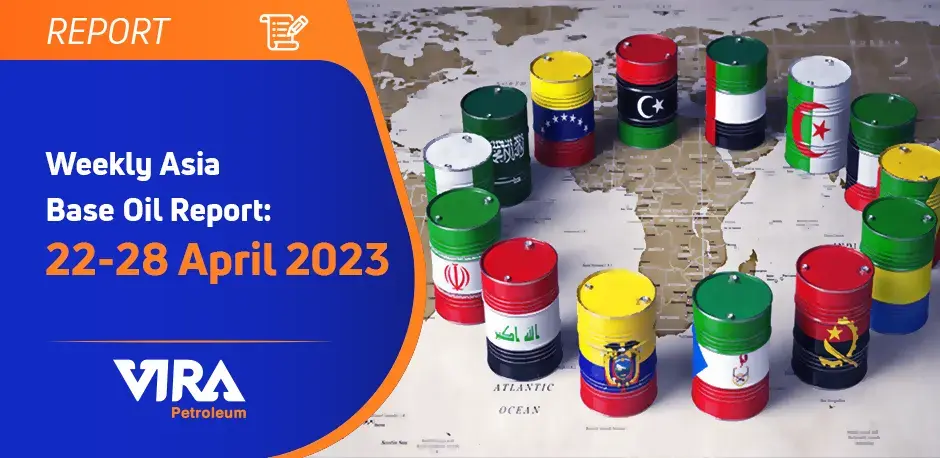As April comes to an end, the pricing structure in Asia has remained relatively stable due to a balanced supply and demand scenario. However, the upcoming holidays in South Korea, China, and Japan are expected to temporarily slow down activity, while the end of the holy month of Ramadan and the Eid al-Fitr holiday is expected to revive trading interest in early May.
read more : Weekly Asia Base Oil Report: 15-21 April 2023
Base Oil Trends In Asia
The volatile nature of crude oil values has continued, with futures experiencing sudden jumps and falls due to global economic concerns and geopolitical tensions. While base oil producers have emphasized that crude prices do not typically have an immediate impact on base oil values, some formula-based prices may be revised on a monthly basis. Despite this, market participants remain vigilant of crude futures as they could affect base oil market sentiment in the coming weeks.
Diesel prices have been a crucial factor affecting the refinery operations and the allocation of feedstocks to fuel or base oil production. In recent times, diesel prices have decreased from the high levels seen earlier in the year. As a result, producers are now focusing on base oil production, which has led to an abundant supply of some grades, particularly in the API Group I segment. This abundance of supply has put downward pressure on pricing.
However, despite the current oversupply of base oils, upcoming planned turnarounds at a number of base oil facilities in Asia may lead to tighter supplies and upward price pressure in May and June. This will be a welcome development for producers, who have seen their margins squeezed in recent months due to the oversupply.
During the month of April, a fire at an Indonesian plant disrupted the base oil supply chain in Southeast Asia. However, the plant was expected to resume operations by the end of the month. Meanwhile, a major base oil facility in Singapore began maintenance work on some of its trains, which could lead to tighter spot availability in the region for the next couple of months.
Order : recycle base oil
Base Oil price In China
In China, a few base oil plants have been operating at reduced rates due to market conditions and tax inspections. While some of these plants have increased their run rates, others have not, and at least two units have scheduled maintenance work this month. Despite these developments, the domestic availability of base oil in China has been sufficient to meet demand, with limited interest in imports noted.
It is worth noting that any disruptions in base oil supply in Southeast Asia and China could potentially impact the global base oil market, as these regions are major suppliers of the commodity. As such, market participants will likely keep a close eye on the situation to determine if it could lead to any significant changes in pricing or supply chain dynamics in the near future.
Base Oil Trends In Asia
The demand for base oils in China has been subdued due to lower price expectations from Chinese buyers. This trend is expected to continue as buyers anticipate a seasonal slowdown in demand from May onwards. However, some shipments from South Korea to China were being considered, with several cargoes expected to be lifted in mid-May.
A 2,700-metric ton lot made up of six grades was expected to be shipped from Onsan to Zhangjiagang and Jingjiang, while a 3,300-ton cargo of three grades was expected to be shipped from Onsan to Huizhou in mid-May. Additionally, there were discussions about a 4,000-ton parcel to be shipped from Ulsan to Zhuhai in early May.
Base Oil Trends In South Korea
In South Korea, a Group II/III producer was planning to take its plant offline for maintenance in June. This could lead to fewer spot volumes being offered by South Korean producers. Nonetheless, suppliers have enough base oils to meet both contract requirements and spot business, with no shortages reported at the moment.
Order: rubber processing oil
Several shipments of base oils were being discussed for delivery to various destinations in Asia. In early June, a 2,200-ton cargo consisting of two grades was being considered for shipment from Yeosu, South Korea to Haiphong, Vietnam. Additionally, a total of 5,700 tons of base oils were on the table for lifting in Yeosu and delivery to Dong Nai, Vietnam, Singapore, and Port Klang, Malaysia in late May. A 1,800-ton parcel was also quoted for shipment from Onsan, South Korea to Bangkok, Thailand in late May. Meanwhile, a 2,000-ton lot of two grades was expected to be shipped from Onsan to Taichung, Taiwan in late May.
However, some producers in Asia were expected to experience maintenance turnarounds that could impact base oil output and limit availability. For instance, a Japanese refinery was anticipated to commence a two-month turnaround in May. This was likely to partly affect base oil production and limit supplies from the producer.
Base Oil Trends In India
In India, buyers continued to rely on domestic supplies and expected additional base oils to become available once shipments from the United States arrived. Details of a 16,000-metric ton lot for shipment from Houston to Mumbai in the first week of May emerged recently, and a 3,000-ton cargo was also mentioned for shipment from Rayong, Thailand to West Coast India and/or the United Arab Emirates in late May.
The recent news was good, as a domestic producer in India has been facing production issues. Group I supplies were limited and Group II availability has become tighter due to some blenders choosing these grades over Group I, given that their prices were comparable. However, Group II offers were observed to have increased by around $20 per metric ton week on week.
Regular shipments from the Middle East and South Korea were also expected to arrive, but spot availability from South Korea may become tighter due to a plant turnaround and suppliers looking for higher prices.
There were optimistic expectations of ample Group III supplies from a Middle East producer that would be available for export to India in the following weeks.
Base Oil price In Asia
Ex-tank Singapore prices for base oil remained mostly stable with minor fluctuations. Prices for the Group I sn150 base oil grade were assessed in a range of $770/t-$810/t on an FOB Asia basis, while the sn500 base oil grade was steady at $870/t-$910/t.
Bright stock prices remained unchanged at $1,010/t-$1,050/t, FOB Asia. The Group II 150N was up by $20/t and assessed at $890/t-$930/t on an FOB Asia basis, while the 500N and 600N grades were heard at $930/t-$970/t, FOB Asia. In the Group III segment, prices were either steady or down from the previous week.
The 4 cSt grade remained steady at $1,520/t-$1,560/t, and the 6 cSt was assessed at $1,490/t-$1,530/t. However, the 8 cSt grade saw a decrease of $20/t, and its prices were assessed at $1,150/t-$1,190/t, FOB Asia, for fully approved product.
| SN 150 | SN 500 | Base Stocks | N 150 | N 500 | |
|---|---|---|---|---|---|
| Singapore | $920/t-$950/t | $1,030/t-$1,070/t | $1,260/t-$1,300/t | $1010/t-$1,050/t | $1,040/t-$1,090/t |
| FOB Asia | $770/t-$810/t | $870–910/t | $1,010/t-1,050/t | $890/t-$930/t | $930/t-$970/t |
crude oil price
Meanwhile, crude oil futures prices bounced back on Thursday after experiencing two significant losses. Despite concerns over economic growth in the US and a potential decline in crude oil demand from the world’s largest consumer, crude oil prices increased slightly due to reports of a huge decline in US crude inventories.
On April 27, Brent June futures prices were at $78.03 per barrel, a slight drop from $81.77/bbl on April 20, on the London-based ICE Futures Europe exchange. Similarly, Dubai front month crude oil (Platts) financial futures prices for May settled at $76.74 per barrel on the CME on April 26, compared to $82.37/bbl for April futures on April 19.

